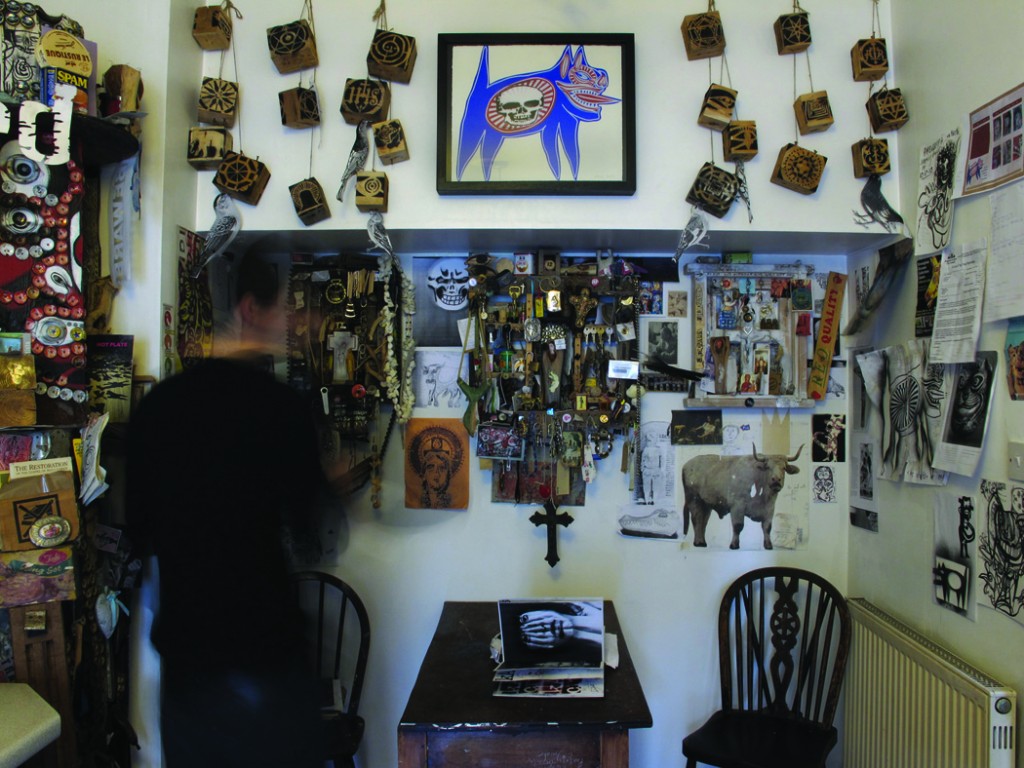
Jim Sanders is a Brighton-based artist who believes art should be timeless, as opposed to a fashion-led commodity. Through his art, he wants to convey the common concerns, or fundamentals of life: religion, birth, love, sex and death. Nicholas Toovey tells us more.

Jim was born in Solihull and raised in Redditch, he did a degree in graphic design and illustration, but soon discovered that the industry was heavily reliant on computers rather than drawing. The degree did however reinforce his love for assemblage and creativity. He moved to Brighton in 1998 deciding to escape his “red brick and concrete 1960s overspill” town in Warwickshire. Does Sussex inspire him? Only in part, he loves spending time ‘people-watching’ in town, and as his work is often figurative, he admits that must be an inspiration. Jim’s work however, is far more influenced by his childhood and his catholic upbringing. He is now interested in all manner of beliefs for what they convey – “I like the imagination of it and the related stories”.
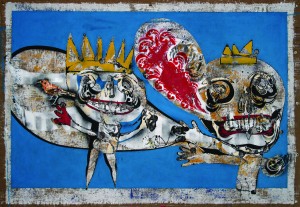
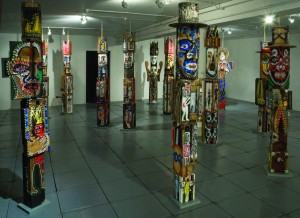
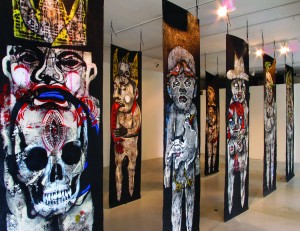
With the exception of his graphic design degree, Jim received no formal training in fine art. This creates a refreshingly naive appeal to his work. His ethos is most akin to ‘outsider art’, this is work usually created by the mentally ill who are untrained and unaware of the art world or art history but whom enjoy the process of making art. Because he is of sound mind and often dips into reference books to further his appreciation of art he quips “I am outside the outsiders, but also outside the insiders!”. His output is primitive and this is often achieved by working with children; they have an unrivalled naivety when painting, born from their unique imagination and executed with an undiluted freshness that is not constrained by conformity. This process first started whilst teaching art to home-schooled children, but developed with the help of two boys, Apollo and Hermes. The eight and ten year-olds often visit Jim’s studio and collaborate with him. The three work together, doodling and getting basics on the canvas, sometimes with direction from Jim, but more often without. Jim then continues to work and develop these basics into a finished work of art. In addition to Apollo and Hermes, Jim often collaborates with other creative types, including poets, musicians and other artists.
Jim regularly creates work in a series; arguably one of the most imposing of these was a group of twenty ‘Totems’ that show his passion for assemblage. Created from found and salvaged materials, such as bottle tops and rusty tools, the totems adopt an autobiographical element, particularly his Catholic background, with each totem reflecting altarpieces and votive offerings. They were exhibited at the Pheonix Gallery, Brighton in 2007. The ‘Totems’ informed his next series, the ‘Shrines’, these are created in his kitchen also from found materials, the Shrines are continually added to with objects sourced for the unknown stories that they tell.
The route of all of Jim’s work is drawing. Whether it be from sketches created with the children he taught, drawings he makes whilst out and about, or ‘automatic’ doodles he makes at the kitchen table whilst cooking dinner. From a selection of over 400 drawings on scraps of paper, twenty figures have been translated in mixed media onto 2.5m high hessian banners, the reverse is plain black with poetry supplied by Xelis de Toro, when displayed in an installation this is all the viewer sees at first. After being lead through, the viewer turns to face ‘The Solitaires’, a powerful crowd of imposing figures that mirror facets of the viewer’s own personality.

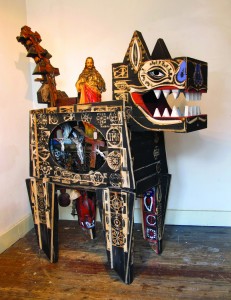
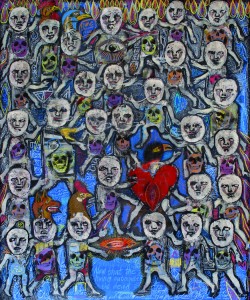
Jim works from his Brighton home, one room is dedicated to his studio, where pictures in progress cover every wall. Hessian is stacked on the floor, which doubles up as the artist’s easel. Due to the courser weave of the hessian, paint seeps through to the sheets below creating all important layers and textures for future paintings. The rest of the house is dedicated to his work, the utilitarian bedroom has a bed and a wardrobe, but the walls are yet again filled with paintings, as is the staircase, kitchen and music room (he is the drummer in the Country-Punk band ‘The Crucks’), even the bathroom has works of art above and even in the bath. Jim has no settee in the house – “sofa’s are for people who watch tv” and with the absence of a television in his home you cannot argue with his logic. Every waking hour Jim dedicates to the creative process, art is his life and he is consumed by it. Jim’s work can often be obtained at Ink’d, Brighton, or direct from the artist. He hopes one day to own a building, ideally a church, filled with a lifetime of his work, creating a permanent museum or ornate temple of his work. For now his home is a diminutive version of what he will hopefully one day create. He is always open to showing people around his house and studio, in its ever fluctuating state, and a visit can be arranged by contacting him via his website.
The thought of penniless artists was arguably a romanticised Victorian notion intended to encourage patronage, but Jim, choosing to fulfil his desire for creativity, probably does fit into this category. More often than not he lives off £50 a week, but remains incredibly upbeat, “I’m not poor, I am rich from the art that surrounds me… the only time I get frustrated is when I have to choose between buying new paint or a loaf of bread”. Although his work is instantly recognisable as his own, he signs his work ‘SANS’, a shortened version of his surname and a synonym of without.
The imagery Jim creates is without question intriguing, even if it sometimes borders on the macabre. The dark undertones of some works only reflect the rudimentary elements of life, it is our own fears and taboos of the subject that can make his work haunting and uncomfortable. This does not make it any less brilliant. Jim paints and creates for himself, driven solely by his desire to be artistic. Although pound notes are always welcome, appreciation of his oeuvre, it seems, is payment enough.
Words such as ‘naive’ and ‘primitive’ may appear derogatory, but the art world has always had a place for this approach to creating work and if anything, it is often considered an accolade. One can look at the folk art of the 19th century or artists of the 20th century, such as Lawrence Stephen Lowry, Helen Bradbury, Fred Yeats and Alfred Williams, all of whom are highly collected names on the resale market today. Will Jim Sanders join this list of artists in the future? You can never be certain, but one thing is for sure – he definitely deserves to.
For more visit www.jimsanders-sans.com
Nicholas’ article was originally published in Sussex Life magazine in January 2012.